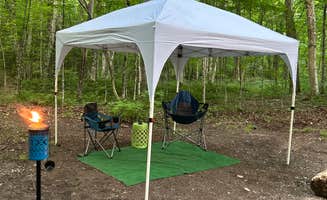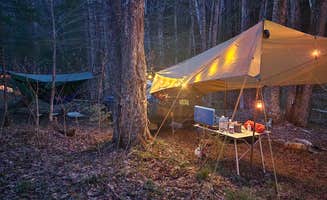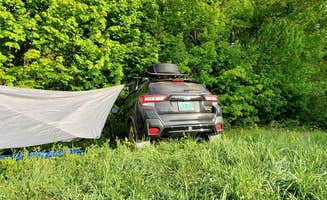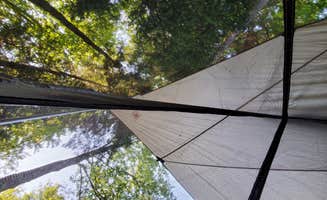Dispersed camping sites near Montpelier, Vermont are nestled within the mixed hardwood forests of central Vermont, typically at elevations between 1,000-2,500 feet. The camping areas follow a seasonal pattern with peak usage from May through October, while winter access becomes limited as many forest roads close after significant snowfall. Primitive campsites generally require self-sufficiency with no trash services or potable water available.
What to do
Waterfall exploration: Austin Brook offers several sites near waterfalls and swimming opportunities. As one visitor noted, "This location is easy to access and has really nice drive in sites." Exploring the natural water features provides relief during hot summer months.
Day hiking: Lincoln Dispersed Camping provides access to nearby trails. A camper shared, "Day 2 we walked past the gate beyond the end of the road followed a trail up 500 feet or so of elevation in the foothills to the west of Mt Ellen." The area connects to longer trails including sections of the Appalachian Trail.
Wildlife viewing: Early mornings and evenings offer opportunities for animal sightings around campsites. The quiet setting attracts various animals, especially near water sources. Moose sightings are uncommon but possible, particularly in less-visited areas during spring and fall.
What campers like
River sounds: Patterson Brookside camp features stream-side camping that many visitors appreciate. According to reviews, "Mountain road lingers along the river. There's quite a few sites along the road. Be sure to camp at spots with established fire rings!" The soothing water sounds create a peaceful backdrop.
Mountain views: Green Mountain Camp on Town Road 11 provides panoramic vistas. A visitor remarked, "The scenic beauty of this place is amazing. There are wide open views of 3 mountain ranges. There are many flowering plants, wild apple trees on the right side of the road." These open field sites contrast with the more forested options.
Primitive solitude: Many campers appreciate the lack of amenities as it reduces crowds. One camper at Forest Road 50 noted, "Pretty remote. Lots of traffic. Found a site that people with a Prius wouldn't be able to get to. Super buggy in June. No cell service. But, plenty of privacy and solitude."
What you should know
Access challenges: Texas Falls Primitive campsites requires careful navigation. According to one review, "There seems to be a little confusion about where restricted day use ends and overnight dispersed sites begin. Some folks were camping in the picnic area." Verify camping regulations before setting up.
Seasonal conditions: Mud season (typically April-May) makes many sites difficult to access. Forest roads become rutted and slippery during spring thaw, requiring vehicles with adequate clearance.
Site closures: Some previously accessible areas face new restrictions. At North Green Mountain Camp, a visitor warned, "Rangers have already started to move boulders into place to block off some of the other sites. It won't be long before the Rangers close this area down due to abuse."
Tips for camping with families
Water safety: When camping near streams, establish clear boundaries for children. Most water features have variable depths and currents that can change quickly after rainfall.
Supply planning: No stores exist near most primitive camping areas. The Lincoln General Store, about 3.5 miles from some sites, offers "modest resupply options" according to campers, but selection is limited.
Wildlife encounters: Green Mountain National Forest FR207 has occasional wildlife visitors. One camper reported, "Woke up to two moose nearby the morning I was leaving." Teaching children proper wildlife safety protocols ensures positive experiences.
Tips from RVers
Vehicle clearance requirements: Most primitive camping areas require higher-clearance vehicles. At FR207, a visitor cautioned, "This is not a place to go without at least 9" of ground clearance." Standard RVs may struggle on forest roads.
Site selection: Arrive early to secure level spots that accommodate larger vehicles. Many primitive sites near Montpelier work better for smaller campers and vans rather than full-size RVs.
Turn-around space: Forest roads often have limited areas to turn around. Scout locations before committing to a site, especially with larger vehicles. Some campers recommend walking the road first before attempting to drive an RV down it.








